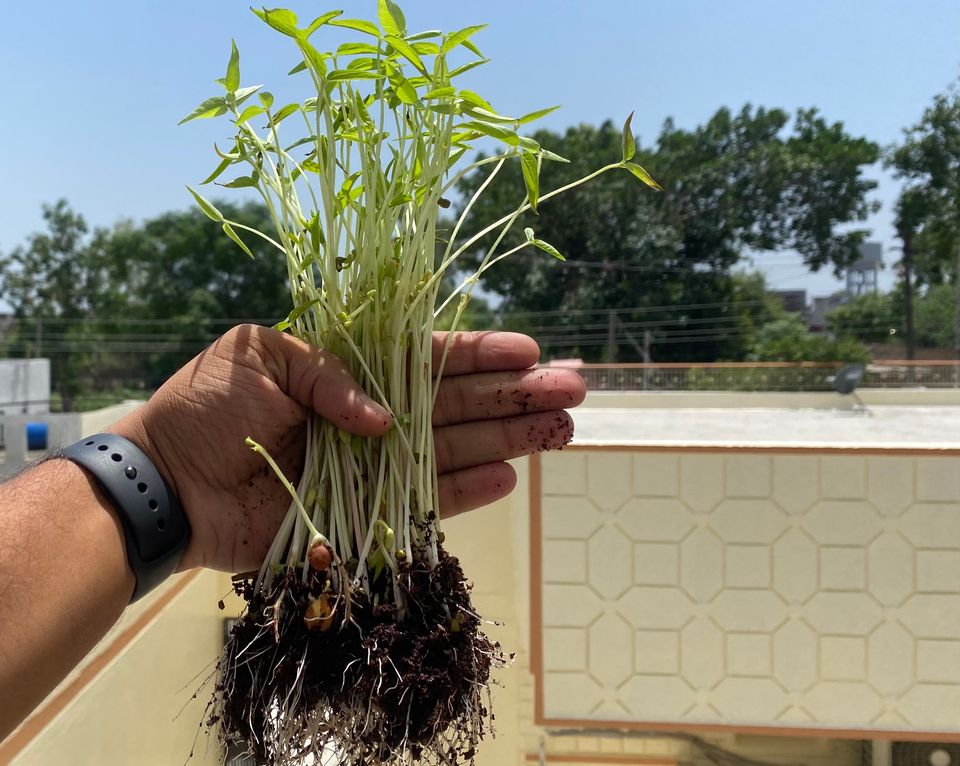Microgreens Explained.

As the name suggests 'micro' means small 'greens' means plants, are simply sprouted vegetable seeds. Growing them is a fun planty project plus you get nutritious food toppings. They are ready to be harvested in 10-12 days and as such requiring no gear and stuff you can even grow them in the boxes you get Biryani from Swiggy/Zomato.
USES OF MICROGREENS: Microgreens are wholesome and nutritious addition to your daily meals which can be used in our dining habit like Salads, Foods and drinks Garnishing, Seasoning the soup or pottage, Sandwiches, Juicing, Appetizer, Microgreens powder and even Stir-fry.
THINGS NEEDED:
- CONTAINER- Any plastic tray which is at least 2 inches deep. Make holes in the bottom of the tray for drainage. If you still cannot find a tray for growing microgreens then simply use the drainage plates we use for 10 inches pots.
- SOIL- For the soil use seed starting soil. Make a blend of equally mixing Cocopeat, Garden soil and Cattle Manure.
- SEEDS- Buy good quality seed to begin with. You can harvest microgreens of turnips, radishes, broccoli, cauliflower, carrots, celery, chard, lettuce, spinach, arugula, amaranth, cabbage, beets, parsley and basil.
If going to nursery for seeds is a task then you can make microgreens of Rajma(Kidney Beans), Kala Chana(Chickpea), Lobia(Black eyed peas) and spices like Methi(Fenugreek) and Sarson(Mustard) to grains like Gehun(Wheat)
GROWING SEASON- THROUGHOUT THE YEAR. If you intend to grow it in winter then covering the pot or tray with a transparent plastic sheet will result in faster growth and if you're using food delivery box then you can cover the box with the lid it was delivered.
BEST TIME- AUGUST TO MARCH.
STEP BY STEP GUIDE:
- First of all fill the tray with the soil mix and make an even surface with your hands. Two to three inches of soil layer is sufficient.
- Mist the top layer of the soil with spray bottle or mister to evenly moisten the soil.
- Spread seeds evenly over the entire surface of the soil. You can even sow different seeds in the same container.

4. Water the container and then place it where it get 4-5 hours of sunlight per day.
5. Mist the seed on a daily basis till they germinate. Dont let the soil dry keep it misted but not waterlogged.
6. Seeds will sprout out in 3 to 7 days, once the seeds have sprouted then spraying once or twice a day is recommended.
7. Harvest the microgreens 14 to 20 days after planting when you can see 2 to 3 inches growth of sprouts. To harvest, cut your microgreens with scissors just above the roots.
Microgreens provide best of nutrition when consumed fresh. Right after the harvest. Wash them thoroughly and store them in a paper wrap in your fridge for further use.
If you keep unaliving your plants then microgreens are a good start. Plus you get to flaunt your unusual acquired taste.

FEW RELATED QUESTIONS
Q: Why microgreens? Microgreens contain 40x more nutrients than their fully grown counterparts.
Q: Are we supposed to cook microgreens? Microgreens lose their nutrients very quickly when cooked, try to eat them raw as much as possible.
Q: Can microgreens be grown outside? Microgreens are a little delicate and like all young seedlings, they are better protected from the cruel harsh world outside. The heat, sun, and wind can dry them out and their tender leaves are an easy target for pests to feast on.
Q: Do microgreens regrow? Unfortunately most can only be harvested one time. Microgreen shoots, like peas, beans, and lentils, are able to grow back a couple of times as long as you harvest them above their bottom leaf. The taste starts to fade after the first harvest, but you can usually get these to regrow once or twice with decent flavor and texture.
Q: Which microgreen grows fastest? Radishes are the fastest-growing microgreens and should be harvested before their first true leaves develop.
What is the lifespan of microgreen? 10–14 daysAs fresh-cut products, microgreens are characterized by a relatively short shelf-life, not exceeding 10–14 days.
Can microgreens be frozen? Like any other food, microgreens can be frozen.
What is the tastiest microgreen? The most flavorful microgreens to try growing are mustard, pea, beet and radish.
This was 1o1 of microgreens. Everything's covered in the blog, rest is covered in related questions. You know everything about microgreens now, champ.
Member discussion